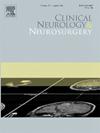经蝶窦手术治疗蝶窦病变后长期糖尿病的预测性机器学习模型的开发与验证
IF 1.8
4区 医学
Q3 CLINICAL NEUROLOGY
引用次数: 0
摘要
目的:尿崩症是经蝶窦手术治疗鞍区病变后常见的并发症。DI通常是短暂的,但在某些患者中可能是永久性的。先前的研究描述了术前发生术后DI的危险因素。然而,尚无预测风险评分来对这些患者进行风险分层。方法对2017 - 2022年所有经蝶窦手术切除鞍区病变的患者进行单中心回顾性分析。长期DI定义为符合DI标准至少6个月且需要去氨加压素治疗的患者。获得基线患者、手术和放射学特征。使用机器学习方法(risk - slim)创建风险分层评分,以识别DI高风险患者。结果经蝶窦手术治疗鞍区病变患者共252例。其中,27例(10.7 %)患者发展为长期DI,需要去氨加压素治疗。经蝶术后DI评分(DITSS)曲线下面积为0.81,校正误差(CAL)误差为7.3 %。预测因素为肿瘤病理、肿瘤大小、患者年龄和内镜入路。发生DI需要长期去氨加压素治疗的概率范围从<; 1 %(评分为0)到>; 95 %(评分为10)。结论:DITSS模型是一种简洁准确的工具,可以帮助临床决策,对接受经蝶窦手术治疗鞍区病变的患者进行风险分层。本文章由计算机程序翻译,如有差异,请以英文原文为准。
Development and validation of a predictive machine learning model for postoperative long-term diabetes insipidus following transsphenoidal surgery for sellar lesions
Objective
Diabetes Insipidus (DI) is a common complication that occurs following transsphenoidal surgery for sellar lesions. DI is usually transient but can be permanent in select patients. Prior studies have described preoperative risk factors for developing postoperative DI. However, no predictive risk score has been created to risk stratify these patients.
Methods
A single-center retrospective review from 2017 – 2022 was performed, reviewing all patients who underwent transsphenoidal surgery for resection of a sellar lesion. Longterm DI was defined as a patient who met DI criteria for at least six months and required desmopressin therapy. Baseline patient, operative, and radiographic characteristics were obtained. A machine learning method (Risk-SLIM) was utilized to create a risk stratification score to identify patients at high risk for DI.
Results
In total, 252 patients were identified to have sellar lesions treated with transsphenoidal surgery. Of these, 27 (10.7 %) patients developed long-term DI and required desmopressin therapy. The DI after Transsphenoidal Surgery score (DITSS) was created with an area under the curve of 0.81 and a calibration error (CAL) error of 7.3 %. Predicative factors were tumor pathology, Tumor size, patient age, and endoscopic approach. The probability of developing DI requiring long-term desmopressin therapy ranged from < 1 % for a score of 0 and > 95 % for a score of 10
Conclusions
The DITSS model is a concise and accurate tool to assist in clinical decision-making for risk stratifying which patients undergoing transsphenoidal surgery for sellar lesions may go on to develop DI.
求助全文
通过发布文献求助,成功后即可免费获取论文全文。
去求助
来源期刊

Clinical Neurology and Neurosurgery
医学-临床神经学
CiteScore
3.70
自引率
5.30%
发文量
358
审稿时长
46 days
期刊介绍:
Clinical Neurology and Neurosurgery is devoted to publishing papers and reports on the clinical aspects of neurology and neurosurgery. It is an international forum for papers of high scientific standard that are of interest to Neurologists and Neurosurgeons world-wide.
 求助内容:
求助内容: 应助结果提醒方式:
应助结果提醒方式:


